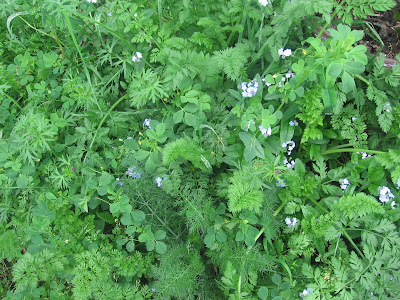
In honor of Earth Week and the 40th anniversary of Earth Day (April 22, 1970 to April 22, 2010) here is a survey of our habitat garden, which is officially registered with the National Wildlife Federation as a place that provides the four basic habitat elements: food, water, cover, and places to raise young.
If you are an organic gardener, it's not a big deal to get an official certification. I filled out a form affirming my earth-friendly ways and the presence of the needed wildlife support elements and mailed it in
(it can be done online also). Registration was free at the time I signed up and a metal sign to put on the house cost $25.00. The sign seemed like a good way to assure the neighbors that the overgrown, Little-House-in-the-Big-Woods atmosphere of our yard was
intentional.
A couple of years ago the roof was being repaired and the roofing contractor, noting the sign, politely asked if it was OK to proceed. Perhaps he thought he was in an endangered species zone and was going to run afoul of the Environmental Protection Agency. The notice does look quite official.
I didn't tell him that it's just part of an educational outreach program of the NWF. They will sign up a balcony or a windowsill with potted plants where insects can take refuge, and have done so for thousands of "habitats" across the country. Every little bit helps.

Our "habitat" is a one-sixteenth of an acre yard at the end of a dead-end street with a redwood grove nearby and a seasonal creek running through the redwood grove. The creek is not in our yard so it doesn't qualify as a water source. But four birdbaths in the backyard do the job quite well.
The birdbath pictured above is shallow so insects can use it.

This one is for birds -- and dogs. I suspect that deer also take a sip in the dry summer months, thought I have never caught them at it. There is another birdbath similar to this one (not pictured), and a fourth (not pictured) which is set low to the ground. The cats use that one, and, I believe, the raccoons because it gets muddy awfully fast. I picture them washing their dapper little paws in the seashell shaped bowl.
As for food, the yard is replete with flowering, seeding, and fruiting plants of all kinds. At this time of year in particular it's abuzz with countless insects hovering over the blossoms.

The rose thicket provides plenty of cover. I've seen raccoons run into the base of it; a deer curled up at the back of it against the fence; and birds diving into the upper reaches of it, which forms a green canopy tree-top tall, mingled with ivy and draped over one of the plum trees.

Here's a close look at the raccoon passageways into the inner depths. As far as I know, no mammals have tried to raise their young in there, although it seems like a good place. Perhaps it's simply not big enough or sheltered enough, being only about ten feet wide and its edges well patrolled by the resident dog-on-duty.
But, higher up, I have seen hummingbirds buzzing in and out in a way that suggests nesting.

One year I think a house finch made a nest in the ivy on the back wall of the house -- again, judging by the constant traffic back and forth. Sometimes from the bathroom window I've noticed a hummingbird gathering the spider webs that dangle from the ivy, most likely to line its nest with.
All in all, in my opinion, we are justified in posting our sign. And it's nice to know we are part of a network of informal refuges across the country.














































